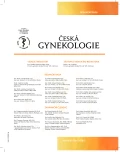Peripheral precocious puberty
Authors:
J. Zvonařová Skalická 1; R. Pilka 2
Authors‘ workplace:
Středomoravská nemocniční a. s., nemocnice Šternberk, primář MUDr. M. Vaca
1; Porodnicko-gynekologická klinika FN a LF UP, Olomouc, přednosta prof. MUDr. R. Pilka, Ph. D.
2
Published in:
Ceska Gynekol 2016; 81(5): 377-383
Overview
Objective:
To summarize literature data on peripheral precocious puberty.
Design:
A literature review.
Setting:
Středomoravská nemocniční a.s., hospital Šternberk, Department of Obstetrics and Gynaecology, University Hospital, Medical Faculty, Palacky University, Olomouc.
Methods and results:
We searched in PubMed using the key words stated below according to date and published since 1980.
Peripheral precocious puberty occurs in girls with the frequency 1:
400–1000. It develops mainly because of peripheral estrogen secretion, the main cause of which are autonomous ovarian cysts. Other causes include McCune Albright syndrome, juvenile granulosa cell tumor and primary hypothyroidism. Typically, peripheral precocious puberty presents with early breast enlargement followed by development of other secondary sex characteristics. Initial treatment is usually conservative with the exception of juvenile granulosa cell tumor where surgery is warranted. Peripheral precocious puberty anti-estrogen therapy seems promising but neither data on its influence on fertility nor data comparing it to surgical treatment are available. Due to the risk of progression into central precocious puberty or McCune Albright syndrome, long-term follow-up is necessary.
Conclusion:
Peripheral precocious puberty should be managed in pediatric gynecology outpatient office and often subsides spontaneously. However, it can also be a sign of malignancy. In most cases, conservative therapy is preferred with medical treatment and surgery warranted in complicated cases. However, optimal treatment has not been established yet.
Keywords:
autonomous ovarian cyst, peripheral precocious puberty, McCune Albright syndrome, juvenile granulosa cell tumor, hypothyroidism
Sources
1. Ashnagar, A., Alvi, S., Nilipour, Y., et al. Massive ascites as the only sign of ovarian juvenile granulosacell tumor in an adolescent: a casereportand a review of the literature. Case Rep Oncol Med, 2013, p. 386725.
2. Baranowski, E., Hogler, W. An unusual presentation of acquired hypothyroidism: the Van Wyk/Grumbach syndrome. Eur J Endocrinol, 2012, p. 537–542.
3. Bedir, R., Murtezaoglu, AR., Calapoglu, AS., et al. Advanced stage ovarian juvenile granuloza cell tumor causing acute abdomen: A case report. Arch Iranian Med, 2014, p. 645-648.
4. Brauner, R., Bashamboo, A., Rouget, S., et al. Clinical biological and genetic analysis of prepubertal isolated ovarian cyst in 11 girls. PloS One, 2010, 5, p. e11282.
5. Chae, HS., Rheu, CH. Precoucious pseudopuberty due to an autonomous ovarian follicular cyst, case report with a review of literature. BMC Res Notes, 2013, 6, p. 319.
6. Costa, MJ., Walls, J., Ames, P., et al. Transformation in recurrent ovarian granulosa cell tumor: Ki-67 (MIB-I) and p53 immunohistochemistry demonstrates as possible molecular basis for the poor histopathologic prediction on clinical behavior. Hum Pathol, 1996, 27, p. 274–281.
7. De Sousa, G., Wunsch, R., Andler, W. Precocious psedopuberty due to autonomous ovarian cysts: a report of ten cases and long- term follow-up. Hormones (Athens), 2008, 7, p. 170.
8. Engiz, O., Berberoglu, M., Siklar, Z., et al. Treatment of autonomous ovarian follicular cyst with long- term anastrozole therapy. Indian J Pediatr, 2009, 76, p. 950.
9. Fakhry, J., Khoury, A., Kotval, PS., et al. Sonography of autonomous follicular ovarian cysts in precocious pseudopuberty. J Ultrasound Med, 1988, 7, p. 597.
10. Hirakawa, M., Nagai, Y., Yagi, C., et al. Recurrent juvenile granulosa cell tumor of the ovary managed by palliative radiotherapy. Int J Gynecol Cancer, 2008, 18, p. 913–915.
11. Koloske, AM., Goldthorn, JF., Kaufman, E., et al. Treatment of precocious pseudopuberty associated with follicular cyst of the ovary. Am J Dis Child, 1984, 138, p. 147.
12. Kroeze, WK., Sheffler, DJ., Roth, BL. G-protein-coupled receptors at a glance, J Cell Sci, 2003, 116, p. 4867–4869.
13. Lightner, ES., Kelch, RP. Treatment of precoucious pseudopuberty associated with ovarian cysts. Am J Dis Child, 1984, 138, p. 126.
14. Lumbroso, S., Paris, F., Sultan, C. Activating Gs alpha mutation: analysis of 113 patients with sings of McCune-Albright syndrome- A European collaborative study. J Clin Endocrinol Metab, 2004, 89, p. 2107.
15. Lyon, AJ., De Grant, DB. Transient sexual precocity and ovarian cysts. Arch Dis Child, 1985, 60, p. 819.
16. Matarazzo, P., Lala, R., Andreo, M., et al. McCune Albright syndrome: persistence of autonomous ovarian hyperfunction during adolescence and early adult age. J Petiatr Endocrinol Metab, 2006, 19 (Suppl. 2), p. 607.
17. Millar, D., Blake, JM., Stringer, DA., et al. Prepubertal ovarian cyst formation: 5 years experience. Obstet Gynecol, 1993, 81, p. 434.
18. Papanikolaou, A., Michala, L. Autonomous ovarian cysts in prepubertal girls. How aggressive should we be? A reviex of the literature. J Pediatric Adolecs Gynecol, 2015, 28, p. 292–296.
19. Partsch, CJ., Heger, S., Sipper, WG. Management and outcome of central precoucious puberty. Clin Endocrinol, 2002, 56, p. 129.
20. Rodriguez-Macias, KA., Thibaud, E., Houang, M., et al. Follow up of precocious pseudopuberty associated with isolated ovarian follicular cysts, Arch Dis Child, 1999, 81, p. 53.
21. Schumer, ST., Cannistra, SA. Granulosa cell tumor of the ovary. J Clin Oncol, 2003, 21, p. 1180–1189.
22. Stanhope, R., Traggiai, C. Precoucious puberty (complete, partial). Endocrin Dev, 2004, 7, p. 57.
23. Van Wyk, JJ., Brumbach, MM. Syndrome of precocious menstruation and galactorhoea in juvenile hypothyroidism: an example of hormonal overlap in pituitary feedback. J Pediatr, 1960, 57, p .416–435.
24. Zou, CC., Liang, L., Dong, GP., et al. Peripheral precocious puberty: a retrospective study for six years in Hangzhou, China. J Paediatr Child Health, 2008, 44, p. 415.
Labels
Paediatric gynaecology Gynaecology and obstetrics Reproduction medicineArticle was published in
Czech Gynaecology

2016 Issue 5
Most read in this issue
- Peripheral precocious puberty
- Current knowledge about HPV infection
- Sexual morbidity of cervical carcinoma survivors
- Acute uterine inversion after delivery
